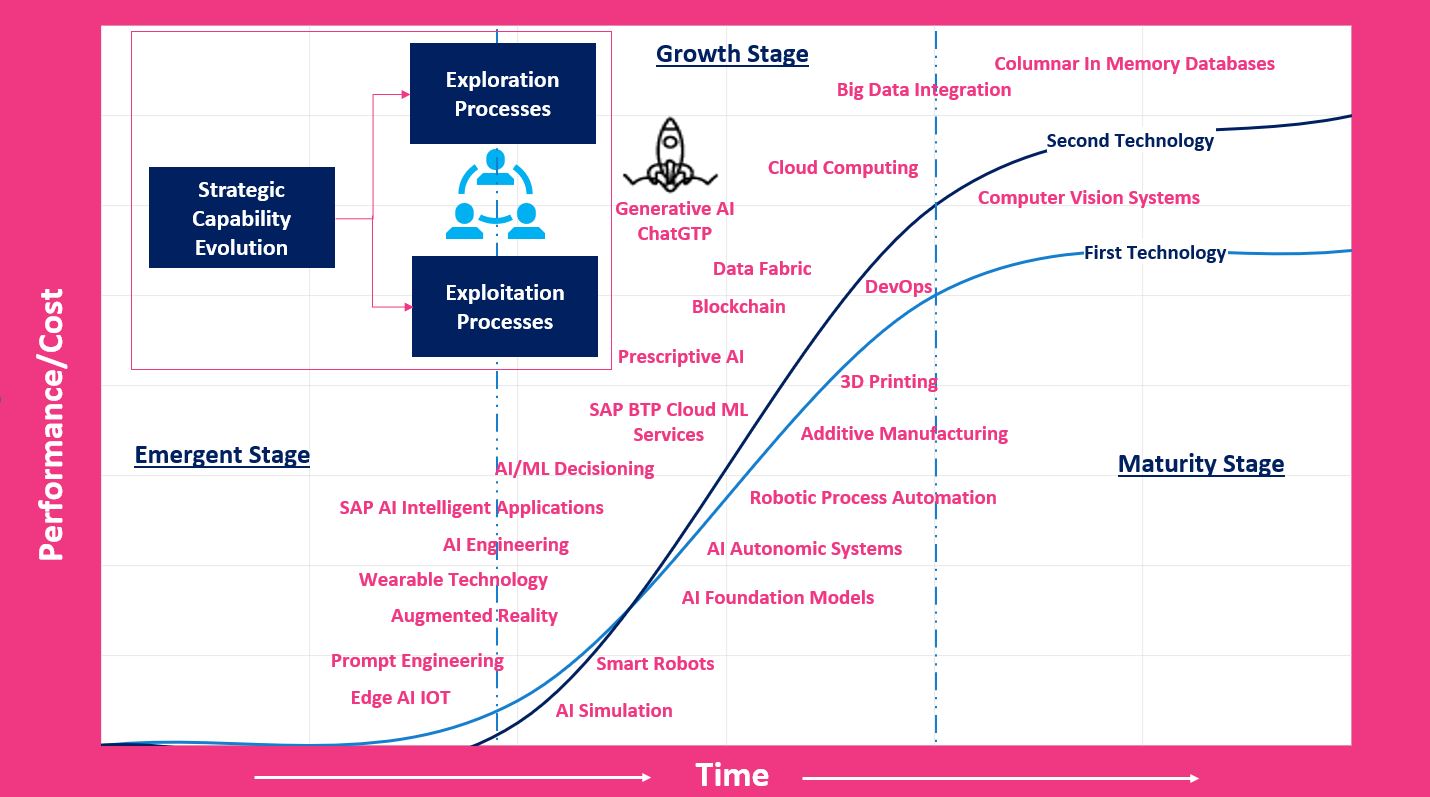Driving Strategic Innovation With Initiatives
Digital technologies are redefining the ways consumers engage and companies compete. Digital strategy is driven by a variety of factors, including current enterprise architecture, changes in consumer behavior, the competitive landscape and technology innovations. AI and ML are being adopted at an ever increasing rate. and are with us to stay. A digital strategy is designed to improve the organization's business effectiveness by using digital technology to improve efficiency, capture new customers, reduce costs and improve employee experience in the organization. Its about making long term decisions while maintaining the tensions between long term and short term needs. A successful digital strategy should include:
- Assessment of the strategic impact of digital
- Making data-based decisions
- Risk management
- Setting streatch goals
- Creating an Ambidextrous Organization capable of both innovation and efficiency improvements
- Evolving organizational capabilities by implementing Exploration and Exploitation processes
- Execution initiatives and transformation management
Understanding Location of World Skills Clusters
Talent and technology clusters exist in various locations throughout the world. Organizations need to hire the most talented people. Talent and technology are globally distributed in clusters. IT strategy cannot be local nor geographically random. Understanding where and why talent and technology clusters of excellence exist is critical to creating a digital strategy which can be implemented.
Demand curves drive the clustering of technology and talent. Talent and technology clusters are driven by global demand. Once the demand is global there are significant benefits to concentrating talent in one place. Talent is superadditive. Skills learn from each other and improve each other due to increasing returns to scale. Knowledge is transfered tacitly, that is face to face interactions and learning.There are fundamental economic reasons that explain why pools of talent or technology knowledge clusters exist around the world, and immigration helps explain these underlying dynamics. Managers need to understand that immigration is not just a political topic, but a strategic opportunity and challenge that affects key business activities, including the ability to be more innovative and make decisions about where to invest and where to recruit.
Developing a Strategy and Analytic Playbook
Where Will You Compete?
Differentiation Strategy and Leadership
- Differentiation is accomplished through product and or service attributes which provide value - improved price points
- Is distinctive
- Focuses on a market segment where there is interest in product or service attributes and the market is willing or pay for the desired attributes
Low Cost Strategy and Leadership
- Provides the lowest costs in the market or industry
- Gains low costs from economies of scale
Often, best costs is a value driven strategy which requires a balancing of market facing strategy with organizational leadership:
- Industry and positioning
- Leveraging and accessing new capabilities
- Neutralizing competition
- Implementing an ambidexterous organization
How Will You Compete?
The skills needed to managing innovation projects which unleash strategic advantage requires integrating teams, innovators and assets. There is a delicate balance between exploration for "new" and exploitation of "old". These skills are deployed across teams focused on the components of innovation shown in the graphic below.
-
Product Innovation:
- Definition: Product innovation involves creating and developing new or improved products, services, or processes by a company or organization.
- Forms:
- New Product Development: Creating entirely new products that fulfill unmet needs or offer unique benefits.
- Product Improvement: Enhancing existing products by introducing new features, improving performance, or addressing customer feedback.
- Line Extensions: Expanding an existing product line by introducing variations (e.g., flavors, sizes) to cater to specific customer segments.
- Cost Innovation: Reducing production costs while maintaining or improving product quality and functionality.
- Busines model innovation: Reimagining how products are created, distributed, marketed and sold
-
Platform Innovation:
- Definition: Platform innovation rapidly iterates upon the platform business model by creating new platforms or improving existing ones.
- Examples: Facebook’s Messenger, Alibaba’s Taobao and Tmall, Amazon’s Marketplace, AWS, and Alexa.
- Paths to Market: In-house development, acquisition, advisory or private equity investment.
-
Commercializing Innovation:
- Definition: Commercializing innovation is the process of taking inventions to market to achieve their intended societal benefit.
- Factors Influencing Success: Market readiness, industry partners, entrepreneurship, and go-to-market strategy.
- Paths to Market: Licensing to industry partners, existing startups or creating new startups.
-
Ecosystem Innovation:
- Definition: Ecosystem innovation involves creating and implementing feasible business models within a network of actors, resources, and conditions. It catalyzes new products, ideas, and systems.
- Importance: Enables collaborative approaches, scalability, and impact on global poveraty challenges.
-
Open Innovation:
- Definition: Open innovation emphasizes using both internal and external resources for enterprise innovation. It involves collaborating with external partners, acquiring inventions, and seeking collaborative innovation.
- Ecosystem Building: Creating an open innovation ecosystem without organizational boundaries, connecting external resources, anjd promoting value co-creation with partners
-
Scaling Innovation:
- Definition: Scaling innovation involves taking successful innovations and expanding their impact to reach a larger audience or market.
- Examples: Expanding successful startups, replicating effective programs, or deploying innovations globally.
- Considerations: Scalability, sustainability and adaptability
What Capabilities Must Be In Place?
While the above looks complicated, strategy can be defined using a strategy playbook that seeks to answer the below questions:
- When you win, what have you achieved against your aspiration?
- Where will you compete, what industries and where are the markets?
- How will you win, price points, efficiency, service and or product features?
- What capabilities must be in place to win, people, innovative technologies?
- What management systems are required, rewards, measurement systems,?
- What choices can we make today which will increase the success of future choices?
- What are the descriptive, predictive and prescriptive analytics needed to continuously improve?
What Management Systems Are Required?
TekMetrix Digital Innovation Strategy Services
We assist defining the latest technologies and how you can reinvent your business model, reassess your value chain, reconnect with customers, and rebuild your organization for the future. To create and drive a modern digital strategy you to:
- Create a strategic technology playbook
- Redesign existing and create new business models
- Taking advantage of crowdsourcing and open innovation
- Digitizing operations
- Designing Omnichannel strategies
- Understanding changing consumer behavior and media habits
- Creating digital, social, and mobile marketing strategies that engage customers
- Acquiring, retaining, and managing customers
- Establishing the right organizational structure and incentive systems
- Building a learning organization that continues to improve its capabilities
- Leading and managing the digital transformation process
What Choices Today to Improve Future Success?
Exploration versus Exploitation Processes

Appendix 1 Ambidextrous Organization
An ambidextrous organization is one that adeptly balances two critical aspects of its operation: exploitation and exploration. The details are:
-
Exploitation:
- Exploitation refers to optimizing existing capabilities, processes, and products.
- It involves efficiently managing day-to-day operations, improving efficiency, and maximizing profits from the current business model.
- Think of it as “harvesting” the fruits of what the organization already knows and does well.
-
Exploration:
- Exploration focuses on innovation, experimentation, and venturing into new territories.
- It involves seeking out novel opportunities, developing disruptive technologies, and exploring uncharted markets.
- Think of it as “planting seeds” for future growth and sustainability.
-
Ambidextrous Organization Characteristics:
- Separation: Ambidextrous organizations create distinct units for exploitation and exploration.
- Exploitative Units: These handle existing operations.
- Exploratory Units: These focus on innovation and new ventures.
- Integration: Despite separation, senior executives maintain tight links across units.
- Ambidextrous Managers: These executives understand both worlds—rigorous cost-cutters and free-thinking entrepreneurs.
- Shared Growth Ambition: The organization aligns both units toward a common goal.
- Separation: Ambidextrous organizations create distinct units for exploitation and exploration.
-
Why Is It Important?:
- Almost every company needs to renew itself through breakthrough products and processes.
- However, this shouldn’t happen at the expense of the traditional business.
- Building an ambidextrous organization ensures a balance between the present and the future
Appendix 2 Where Will You Compete?
-
Definition:
- “Where Will You Compete” refers to the strategic decision-making process wherein an organization identifies and selects specific areas or domains in which it will compete.
- This is a strategic decision of choosing markets, customer segments, product categories, geographic regions, and channels where the organization will focus its efforts.
-
Key Considerations:
- Geography: Which countries or regions will the organization target for its products or services?
- Product Type: What specific offerings (products or services) will the organization provide?
- Consumer Segment: Which groups of consumers will the organization serve?
- Channels: Through which distribution channels (e.g., direct sales, online platforms, retail partners) will the organization reach its customers?
- Stages of Production: Which parts of the value chain (from raw materials to end products) will the organization participate in?
-
Importance:
- Defining the Playing Field: The choice of “Where Will You Compete” defines the boundaries of the organization’s business. It clarifies what markets and customer needs the organization will address.
- Strategic Focus: By making deliberate choices about where to compete, the organization can allocate resources effectively and avoid spreading itself too thin.
- Alignment with Capabilities: The selected playing field should align with the organization’s strengths, capabilities, and core competencies.
-
Example:
- Imagine a business deciding where to play:
- Will the business sells only locally or should they expand to neighboring geographies?
- What products and services will they develop to sell?
- Will the products and services be differentiated, low cost or hybrid?
- Should the business sell directly to consumers or through intermediaries?
- If manufacturing is involved, should it be done in-house or outsourced?
- Imagine a business deciding where to play:
-
Strategic Alignment:
- Where Will You Compete choices should reinforce each other and align with the organization’s overall strategy.
- Once the playing field is defined, the next step is to determine “How to Win” within those chosen areas.
In summary, “Where Will You Compete” is about making deliberate decisions on where the organization will compete, ensuring alignment with its capabilities and market opportunities.
Appendix 3 How Will You Compete?
-
Definition:
- “How Will You Compete” refers to the specific actions and approaches an organization will take to achieve its strategic objectives.
- It focuses on the tactics, competitive advantages, and operational choices that will enable the organization to succeed in its chosen markets.
- What is the best value proposition, the best combination of differentiation and cost
- Understanding customer preferences that drive their willingness to pay (WTP) drives differentiation
- Cost efficiencies, process, scale, systems for the best cost position based on a given level of differentiation
-
Key Considerations:
- Competitive Advantage: How will the organization differentiate itself from competitors? What unique value proposition will it offer?
- Business Model: What revenue streams, cost structures, and distribution channels will the organization use?
- Resource Allocation: How will the organization allocate its resources (financial, human, technological) to execute its strategy?
- Execution Plan: What specific initiatives, projects, and milestones will drive the strategy forward?
-
Importance:
- Execution Bridge: While strategic thinking defines the overall direction, “How Will You Compete” builds the bridge between strategy and execution.
- Alignment: It ensures that everyone in the organization understands their role in achieving strategic goals.
- Adaptability: As market conditions change, the organization can adjust its tactics while staying true to its strategic intent.
-
Example:
- Imagine a global CPG Company:
- How Will You Compete: The company will focus on a seamless user experience, personalized recommendations, and fast delivery.
- Tactics: Implement AI-driven product recommendations, optimize website speed, and negotiate partnerships with reliable couriers.
- Imagine a global CPG Company:
Appendix 4 What Capabilities Must Be In Place?
-
Organizational Capabilities:
- Organizational capabilities refer to the intangible, strategic assets that an organization draws upon to execute its business strategy, accomplish tasks, and satisfy customers.
- Skilled resourced, focused assets, dedicated systems
- Technology alliances and partners.
- Capabilities are not borrowed from external templates; they are acquired and refined internally through various interactions.
- Organizational capabilities include expertise, processes, knowledge, skills, technologies, and unique adaptive features.
- The strength and alignment of these assets define a company's inentity and differentiate it from competitors.
-
Why Are Organizational Capabilities Important?
- Successful companies possess distinct combinations of capabilities that set them apart. It’s not just their structures but their knack for innovation, adaptability, and customer-centric approaches that make them stand out.
- Organizational capabilities play a pivotal role in:
- Gaining Competitive Advantage: Effective resource management and information utilization enable organizations to meet customer demands with distinctive products and services.
- Driving Success: Companies that excel in organizational capabilities deliver deliver excellent service and satisfaction to customers which leads to success
-
Strategic Planning and Capabilities:
- When crafting a strategic plan, organizations must consider the following capabilities:
- Demand Sense: Understanding and monitoring customer preferences, demand management, forecasting, and demand sensing.
- When crafting a strategic plan, organizations must consider the following capabilities:
-
SAP Ecosystem:
- S4 and BW4 most often is the core ERP system for large and small corporations, transactions and reporting must be in real time:
- Hana and Data Modeling: Bundles data from various formats and sources into meaningful queries.
- Data Procurement: Gathers data from different systems and integrates it.
- Analysis and Insights: Provides agile access to information through BW Workspaces.
- Security
- BTP data, analytics, AI, application development, automation, integration
- SAC
- Hana-R
- S4 and BW4 most often is the core ERP system for large and small corporations, transactions and reporting must be in real time:
Appendix 5 What Management Systems Need To Be In Place?
- Innovation Management Processes
- Program Office and Project Management
- IT Strategy and roadmap
- Initiatives and wwnership
- A deep understanding of the business
- Open versus closed Innovation business models
- Manage increasing R&D, IT costs
- Open innovation increases the velocity of change
- Stratetic innovation partnerships
- Open versus closed architecture
-
Integrate SAP Business Processes and Anaytics with AI:
- Integration Points:
- Finance: Enhance financial processes with intelligent invoice matching, error resolution, and fraud detection.
- Supply Chain: Automate communication-heavy processes and gain real-time insights.
- Procurement: Streamline procurement operations using AI-driven guidance.
- Sales and Marketing: Leverage AI for personalized experiences and efficient lead-to-cash processes.
- Human Resources: Optimize recruitment, employee management, and talent development.
- IT and Platform: Integrate AI across the entire technology landscape
- Integration Points:
-
Generative AI:
- Use Generative AI to create new content, such as images, text, or music, based on patterns learned from existing data.
- Applications: Software design, development, SAP configuration, integration, data modeling
-
Integrated Approach:
- Robotic process automation
- Integrated APO, SD MM, FI CO, IBP, TPM, ATMA, SAC, Hana, CRM S4 BW4
Appendix 6 What Choices Today To Improve Future Success?
- Aligned business and technology strategies
- Strategic technology planning
- Expand with complementary products
- Explore new markets and regions
- Target new customer segments
- Prepare AI, chatbots and human like interactions
- Understand how the organization access and interact with information
- Choose a set of technology tools which compliment the existing technology platform
- Maintain a platform strategy
- Maintain a clean data strategy
- Prepare for future Mergers, Acquisitions, Divestitures
-
Develop frameworks and strategies to accurately budget, forecast, and avoid pitfalls related to hardware vs. systems thinking





